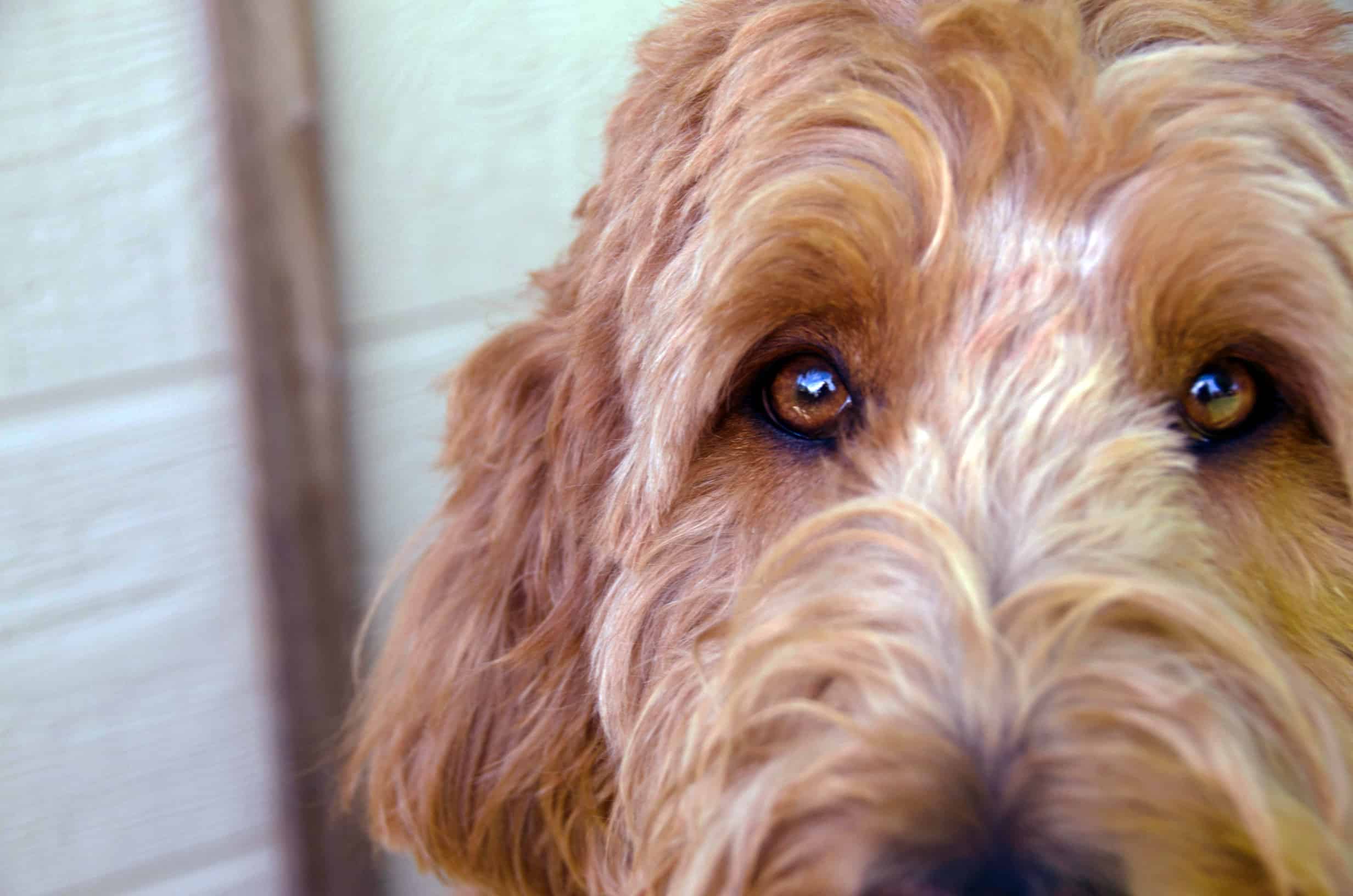How To Help A Labradoodle That Is Scared Of Everything
Owning and caring for a dog can be enjoyable and challenging at the same time. Dogs are lovable, affectionate, and loyal. Besides these qualities, they also have different personalities and quirks- just like us!
So, how do you help a Labradoodle that is scared of everything?
You can use various tactics including being patient with your dog, demonstrating calmness, not ignoring your dog’s jumpy behavior, diverting your dog’s attention, training tactics, positive reinforcement, helping your dog to “warm-up” to new experiences, not punishing your scared dog, communicating, and visiting your veterinarian with serious concerns.
With different quirks and personalities, pet owners likely will not know the personality of their Labradoodle before adoption. This fun-loving puppy has plenty of personality and can make a great best friend! To help your dog live his best life, it is important to know how to care for him, especially if he is easily frightened.
10 Tips For Calming Down Your Fearful Labradoodle
Labradoodles can be frightened for a variety of causes including loud noises and sounds (thunder, vehicles), strangers, other dogs, car rides, walking up and down the stairs, and quick or sudden movements, among others. Some dogs only show fear of perceived threats. However, some dogs seem overly timid and can even act as if they are scared of absolutely everything. If this is the case with your Labradoodle, here are a few tips to help:
- Be patient and don’t give up. This is by far the most important tip since you will be your dog’s main source of love, support, and comfort. Be patient with your dog; if one strategy works for the first time, it may or may not work the second time. Don’t give up, and keep trying out various tactics until both you and your dog seem content in his or her behavior.
- Demonstrate calmness for your dog to mirror. Comfort your dog by using a soothing, quiet voice – similar to what we would use to our fellow (scared) humans. Getting angry and irritated will not help; it will only aggravate the dog even more. Use a calm tone when giving commands and give them treats if available.
The Labradoodle is very sensitive to their owners’ body language and can sense your feelings through your voice (if you are angry, calm, happy, etc.). By showing your dog that you are calm, he will be quicker to calm down as well. - Do not ignore your dog’s jumpy behavior. Do something about it as early as possible. Your dog’s jumpiness about various triggers might pass, but it may also develop into a more severe condition that can possibly disrupt your (and your dog’s) normal activities.
One example of this would be constant barking and aggression due to the dog’s fear of other people or the presence of guests – fearing even the people living with you or closest to you (such as your family and friends). The incessant barking will surely agitate you and your family (and your guests!) in the long run, so it is important to pay attention to your puppy’s weariness early on. - Divert your dog’s attention. In some cases, you can use diversion as a temporary solution to your Labradoodle’s anxiety. For example, you can use playtime to divert your dog’s attention during a thunderstorm, or you can also watch television together during that time. This may also be considered as a training technique since you are teaching the dog to be obedient and to pay no attention to the fear.
However, it may not work in all cases, such as when the dog is alone at home. Some dogs may cave in to their fear due to your absence. In this case, a more comprehensive and long-term training would be required. (See next tip.) - Train your dog to help overcome or reduce fear. It is recommended to start training your dog early, especially if your Labradoodle is still a puppy. Ideally, the puppy’s mom will initially start the training. At this early stage, the puppy will learn about: the typical behavioral patterns of dogs (e.g. dominance, submissiveness, etc.), barking, biting and getting bitten, and social relationships with other dogs, among many other things. All of this will have a huge impact on the dog’s further development.
Paying attention to your dog’s triggers can help you to figure out the best way to approach training her. For example, if your Labradoodle’s phobia is fear of other dogs, it is highly likely that your dog lacked socialization during its early years. Your Labradoodle might also get skittish in the presence of strangers. Train your dog by providing opportunities for socialization – little by little. For example, you can let your furry friend spend time with the neighbor’s dog – just make sure that the other dog is calm and friendly so your dog will more easily adapt to the other dog’s behavior.
If you see improvements, next you can try bringing your dog to the park – where she will likely see many other dogs. Monitor your Labradoodle’s reaction and temperament. It is important to remember that training comes with trial and error, so be patient if your dog takes a little while to “warm-up” to his or her perceived threats. Techniques may also vary depending on the situation or the nature of the trigger. But don’t worry, you and your dog will eventually get there – no need to rush. - Positive reinforcement of trained behaviors. Let’s use an example in which many dogs are frightened: car rides. Many Labradoodles fear riding in cars due to motion sickness, a trip to the vet, feelings of unfamiliarity, or any other past negative experiences. You can train your dog to overcome this fear by starting with positive reinforcement: lure or entice your dog to enter the car by giving treats.
If your dog finally gets inside, make sure that the dog is comfortable and calm before starting the car. If your dog is still skittish, open the windows and doors if needed and sit with them. Do this anytime you need to. Your dog will get used to the car and will associate it with safety and comfort. - Help your dog “warm-up” to new experiences. Another commonly scary scenario for dogs is a trip to the groomer. In this example, the cause for this fear could be related to the fear of car rides or the dog is just not used to being groomed and/or handled by strangers. Train your Labradoodle by grooming at home as the first step of training. Once the dog gets used to it, likely, he won’t have any problems with a professional groomer. Also, it will help if you tour your dog around the groomer’s place – his/her fear may also be due to unfamiliarity.
- Do not punish your dog if he/she gets scared. Your Labradoodle’s fear of something might be trivial to you, but not to the dog. Rational or not, your dog’s fear will only escalate if you punish nervous/skittish behavior. Instead, help your dog to be confident by giving praise and encouragement. They may or may not understand what you are saying but the support you are extending (with the calm voice) will surely get across.
- Communicate with your dog. All the aforementioned tips will always involve good communication with your pet. However, there is one more important thing regarding communication: show your Labradoodle that his/her fear can be ignored. This is actually similar to the diversion tip #2 but sans the diversion. Your Labradoodle can sense your emotions; if you are scared, the dog will most likely get scared as well. The Labradoodle is quite intelligent. You can use your voice and body language to influence your dog’s behavior. If you communicate that it’s no big deal (the fear of something), then most likely your dog will understand.
For example, if your Labradoodle is scared of sirens and tends to hide under the couch or bed whenever an ambulance or fire truck passes by, coax him/her out of their hiding place and tell them in a confident voice that it’s (the sirens) nothing and go on as if the stimuli isn’t there. The dog will eventually understand the message and will most likely exhibit confidence as well. In the same manner, if your dog senses your tension, that feeling will also manifest in your dog. - Visit your veterinarian. If you feel like your Labradoodle’s case is really bad (or you feel like nothing is working) and you are unsure how to take the next step, visit a veterinarian who also specializes in behavioral problems. As an expert, the vet can analyze your dog’s situation and recommend medical treatment for severe conditions. He/she can also provide behavioral therapy for your Labradoodle.
With all of these tips in mind, it is important to remember that your Labradoodle likely has an explanation for their behavior. Your Labradoodle has his own personality and will continue to change behaviors throughout his life. While it can be frustrating to watch your dog fear the world in its entirety, it is important to remember that it is your job, as a pet owner, to help your dog feel loved, safe, and protected.
Related Questions
Does My Dog Have Anxiety?
Pet owners can become frustrated and concerned about their pets when they seem anxious. A dog may have anxiety if he or she is exhibiting the following behaviors: extreme unease when faced with a perceived threat, consistent pacing back and forth, displayed unease with an environment (which is otherwise safe) or separation from his or her owner, and more.
To check for uneasy/anxious physical display, you might see your dog’s ears back (with concern rather than excitement), shortness of breath, increased heart rate and panting, and more. Talk to your veterinarian if you believe your dog is exhibiting anxious behaviors in which you are unable to help ease.
Do Dogs Get Separation Anxiety?
Separation anxiety occurs when a dog experiences anxious behaviors and tendencies when separated from his or her owner for a prolonged period. While some dogs would view “prolonged” as the time it takes for you to move from your couch to your dining room, other dogs view this as when you leave the house and they are not able to see you. The level of separation and anxiety varies from dog to dog but is fairly common.
Behaviors of separation anxiety include: scratching the door after you leave, whining when they cannot see you, extreme displays of sad behavior upon separation, and more. If you feel that your dog is experiencing separation anxiety, it is important to research possible ways to help your dog to improve his overall mental and physical health.


